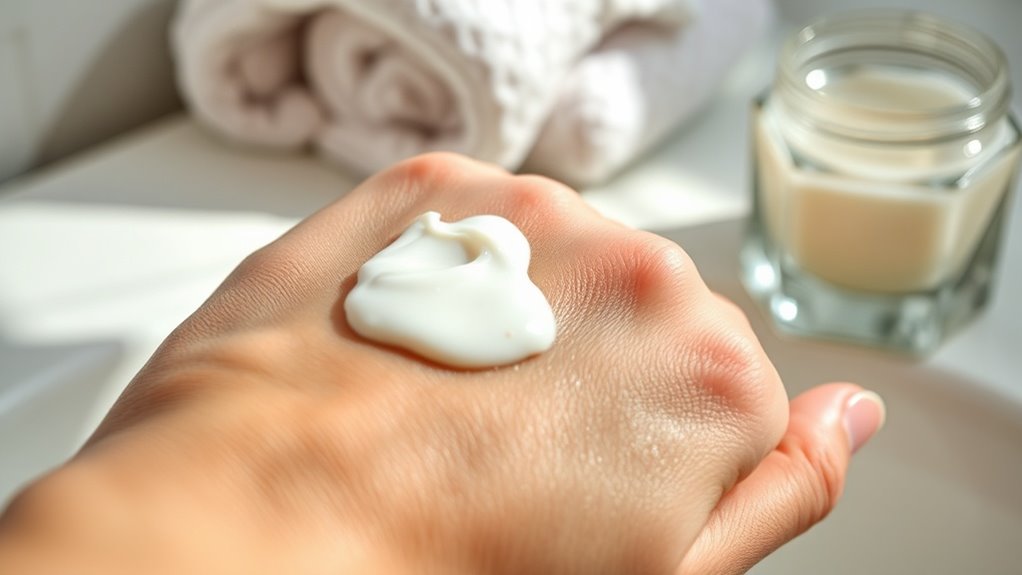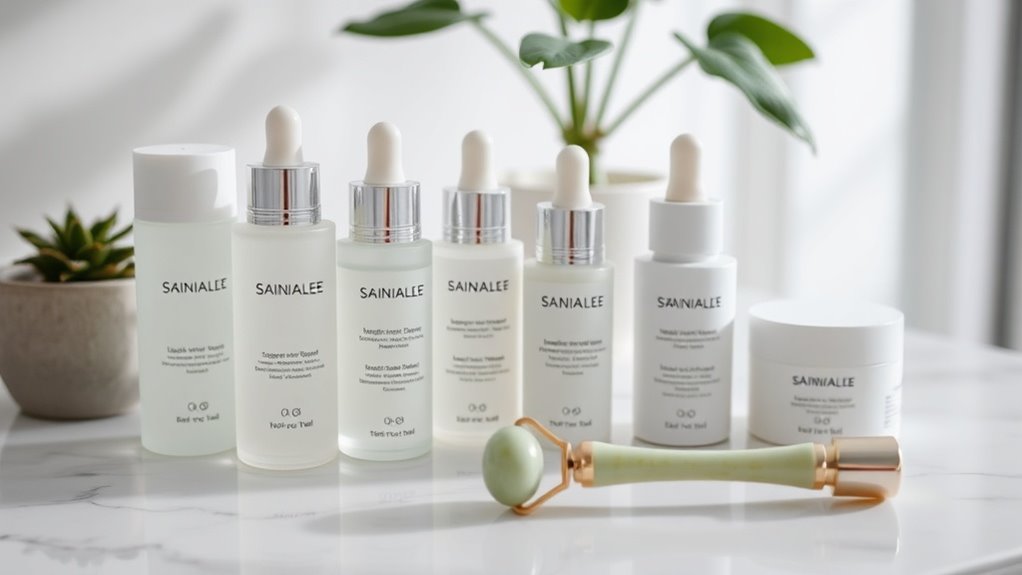Is Your Skin Dry or Dehydrated. Here’s How to Tell (And Fix It)
You might confuse dry skin, which lacks natural oils and feels rough, flaky, and itchy, with dehydrated skin that’s just thirsty for water, showing tightness, dullness, and fine lines. To identify your type, check moisture after cleansing or test for oil with a tissue—it’s a simple, practical step. Fix dry skin using oil-based creams and emollients, while hydrating serums like hyaluronic acid replenish dehydration. Dive into more strategies and nutritional tips for lasting, balanced skin health.
Key Takeaways
- Dry skin lacks natural oils, causing roughness, flaking, and irritation, while dehydrated skin lacks water, leading to tightness and dullness.
- To identify dry skin, look for a rough texture, visible scaling, and persistent itching after cleansing.
- Signs of dehydrated skin include a tight feeling, fine lines, and a dull complexion, often regardless of oil levels.
- Fix dry skin by applying oil-based emollients like petrolatum to restore the skin’s protective barrier.
- Treat dehydrated skin with water-rich ingredients, such as hyaluronic acid serums, to boost hydration and moisture retention.
What Is the Difference Between Dry and Dehydrated Skin?
While dry skin lacks natural oils, leading to a rough, flaky texture, dehydrated skin simply means your skin isn’t getting enough water, regardless of its oil levels.
Understanding this difference is key to an effective dry skin fix; you’re addressing oil barriers for dry types, not dehydration.
Dermatological evidence shows that oil-based creams restore dry skin’s barrier, while water-rich serums replenish hydration.
So, you assess your skin’s needs first—boost oils if it’s dry, add water if dehydrated—to maintain a healthy balance and prevent issues.
Furthermore, incorporating lifestyle changes like increasing water intake and using moisturizing products can enhance overall skin vitality.
Stay consistent for optimal results.
Additionally, recognizing key signs like a dull complexion or increased sensitivity can aid in early detection of dehydrated skin.
Common Signs of Dry Skin
How do you spot the signs of dry skin? As a dermatologist-backed guide, focus on your skin’s surface for clear indicators. To maintain optimal hydration, consider incorporating layering techniques into your skincare regimen for sustained moisture.
Dry skin results from a weakened barrier, often due to low oil production, making it feel tight and uncomfortable.
-
Feel the rough, sandpaper-like texture that drags under your fingertips, signaling a lack of natural oils.
-
Notice visible flaking or scaling, like fine snow dusting your cheeks, highlighting surface dehydration.
-
Experience persistent itching that builds as your skin cracks, urging you to seek relief.
-
Observe redness and irritation, resembling a wind-burned landscape, from environmental stressors.
To combat these effects during winter, incorporate moisturizing techniques into your daily routine.
Common Signs of Dehydrated Skin
If you’re dealing with dehydrated skin, you’ll often notice tightness that makes your face feel stretched and uncomfortable.
This sign occurs because your skin’s moisture levels drop, disrupting its natural barrier.
Pay attention to these cues so you can take practical steps to restore hydration based on evidence from dermatological studies. Additionally, poor sleep quality can worsen skin dehydration by affecting the body’s natural repair processes.
One effective ingredient to address this issue is hyaluronic acid, known for its ability to attract and retain water in the skin.
[LIST OF 2 SUBHEADING DISCUSSION POINTS IN ENGLISH
Dehydrated skin reveals clear signs that signal the need for better hydration.
You can spot these issues early by paying attention to your skin’s responses, backed by dermatological evidence showing hydration’s role in maintaining barrier function.
-
Dull complexion: Your skin loses its natural glow, appearing flat and lifeless under light.
-
Fine lines prominence: You see exaggerated wrinkles, as if your face is pleading for water.
-
Flakiness and roughness: Patches feel like sandpaper, creating a textured, uneven surface.
-
Increased sensitivity: Your skin reacts more to products, stinging as if it’s crying out for moisture.
Skin Tightness
Skin tightness often signals dehydrated skin, pulling uncomfortably across your face as if it’s shrinking for moisture. This sensation arises when your skin’s barrier loses water, often due to environmental factors or insufficient hydration, as confirmed by dermatological research.
You’ll feel it most after washing or in low-humidity settings, distinguishing it from dry skin’s flakiness. To address it, hydrate internally by drinking at least eight glasses of water daily and externally with a hyaluronic acid-based moisturizer.
Consistent routines prevent further damage, restoring suppleness and comfort quickly.
Simple Ways to Identify Your Skin Type
To identify your skin type accurately, start by feeling your skin for its natural moisture and tightness.
You’ll then check oil levels by gently pressing a tissue to see if it picks up shine in different areas.
Observing texture signs, like flakiness or smoothness, gives you clear, evidence-based clues to distinguish between dry and dehydrated skin. Additionally, ensure that your cleansing routine includes water temperature considerations to prevent further dehydration.
Incorporating little-known testing methods can provide additional insights for a more precise skin type evaluation.
Feel Your Skin
How can you quickly assess your skin’s type by touch? It’s simple and effective—use your fingertips to evaluate texture and sensation right after cleansing.
This method, backed by dermatological experts, helps distinguish dry from dehydrated or oily skin without tools.
-
Tightness test: Gently press your cheeks; if they feel taut or stretched, you’re likely dealing with dry skin.
-
Oil detection: Run fingers across your forehead; a slick residue signals oily areas, common in combination types.
-
Smoothness check: Feel the back of your hand; silky texture suggests normal skin, while roughness hints at dehydration.
-
Bump assessment: Lightly touch your chin; small bumps or unevenness may indicate clogged pores in oily skin.
Check Oil Levels
Assessing oil levels gives you a clear edge in pinpointing your skin type. To check this, press a clean blotting paper against your forehead and cheeks after cleansing.
If it picks up oil, you’ve got oily skin; minimal transfer suggests normal or dry types. Studies from the Journal of Investigative Dermatology confirm that sebum production directly influences skin classification.
Use this daily for accuracy—do it in natural light and avoid moisturizers beforehand. This method empowers you to tailor your routine, preventing issues like clogged pores or flakiness, based on real-time evidence.
Stay proactive for balanced skin.
Observe Texture Signs
Beyond checking oil levels, you can easily spot your skin type by examining its texture, which reveals clues like roughness, smoothness, or tightness.
Backed by dermatological research, this practical approach helps you differentiate dry from dehydrated skin quickly.
-
Rough texture: Feels gritty or uneven, signaling dry skin lacking oils.
-
Tight sensation: Skin pulls taut after cleansing, indicating dehydration from water loss.
-
Smooth surface: Appears velvety and supple, showing good hydration.
-
Flaky patches: Shows peeling or bumps, pointing to buildup needing exfoliation.
Effective Treatments for Dry Skin
While dry skin can disrupt your daily comfort, effective treatments focus on restoring the skin’s natural barrier and hydration.
Clinical studies highlight emollients like petrolatum, which seal in moisture by mimicking natural lipids. You can incorporate ceramide-rich creams to repair the barrier, reducing irritation and flakiness.
For persistent issues, dermatologists recommend prescription options, such as topical retinoids, to promote cell turnover without over-drying.
Always choose fragrance-free formulas and apply post-shower for optimal absorption.
Evidence shows consistent use prevents recurrence, so prioritize products backed by research for reliable results. Moreover, excessive exfoliation can lead to premature aging by damaging the skin’s protective barrier.
To complement these treatments, it’s essential to address common pitfalls in skin care by avoiding over-exfoliation, which can exacerbate sensitivity and lead to further dryness.
Proven Strategies to Restore Skin Moisture
Restoring your skin’s moisture starts with targeted strategies that build on treatments like emollients. For natural and cost-effective solutions, try incorporating kitchen ingredients into your routine.
You’ll lock in hydration by combining proven methods that address both surface and internal factors, backed by dermatological research showing improvements in barrier function and elasticity.
-
Envision applying a hyaluronic acid serum****: Feel it drawing water into your skin, plumping fine lines for a dewy glow.
-
Picture drinking ample water****: Imagine it flushing toxins, enhancing your skin’s natural radiance from within.
-
See yourself using a humidifier: Watch it release fine mist, restoring room humidity to prevent evaporation.
-
Visualize eating omega-3 foods****: Think of salmon nourishing your cells, strengthening the skin barrier against dryness.
Additionally, by avoiding dietary choices that harm your skin, such as excessive sugar intake, you can enhance these strategies with healthier options to support long-term hydration.





